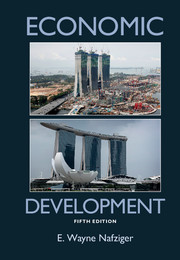Book contents
- Frontmatter
- Contents
- Preface to the Fifth Edition
- Abbreviations and Measures
- Part One. Principles and Concepts of Development
- Part Two. Poverty Alleviation and Income Distribution
- Part Three. Factors of Growth
- Part Four. The Macroeconomics and International Economics of Development
- Part Five. Development Strategies
- Glossary
- Bibliography
- Index
- Endpapers
Preface to the Fifth Edition
Published online by Cambridge University Press: 05 June 2012
- Frontmatter
- Contents
- Preface to the Fifth Edition
- Abbreviations and Measures
- Part One. Principles and Concepts of Development
- Part Two. Poverty Alleviation and Income Distribution
- Part Three. Factors of Growth
- Part Four. The Macroeconomics and International Economics of Development
- Part Five. Development Strategies
- Glossary
- Bibliography
- Index
- Endpapers
Summary
I wrote this text to increase readers’ understanding of the economics of the developing world of Asia, Africa, Latin America, and East-Central Europe, where about 85 percent of the world's population lives. The book is suitable for students who have taken a course in principles of economics.
The growth in real income per person in the Third World nations of Latin America, Asia, and Africa, about threefold since 1950, is a mixed record. For some economies, the growth warrants optimism, particularly in Taiwan, South Korea, Singapore, Malaysia, Thailand, Indonesia, China, other fast-growing Pacific Rim countries, Brazil, and, more recently, India. The tragedy, however, is that sub-Saharan Africa, encountering growing misery and degradation from 1965 to 2010, has not shared in these gains. The sub-Sahara is not only vulnerable to the external price shocks and debt crises that destabilized the global economy in the late twentieth century but also is plagued by increasing food deficits, growing rural poverty, urban congestion, and falling real wages; difficulties that represent an inadequate response to adjustment, reform, and liberalization, often imposed by the International Monetary Fund (IMF) or World Bank as a last resort. The problems of Nepal, Afghanistan, Myanmar (Burma), Cambodia, and Haiti are as severe as those of Africa.
Information
- Type
- Chapter
- Information
- Economic Development , pp. xiii - xxiiPublisher: Cambridge University PressPrint publication year: 2012
